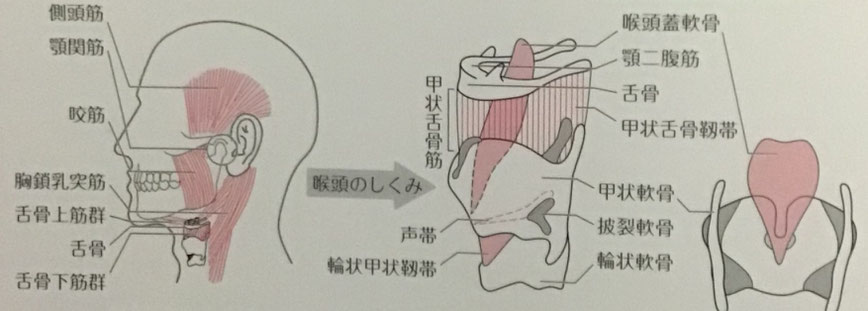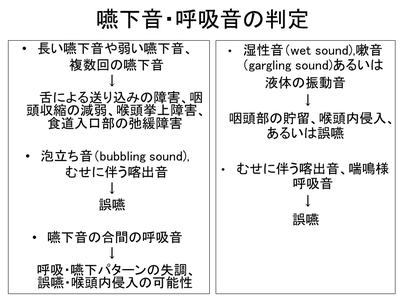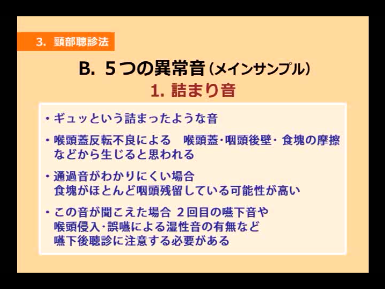Fundamental Lesson of Cervical Auscultation Method
About Cervical Auscultation Method
Cervical auscultation method is, in medical terms, "------------------------".
It sounds difficult, isn't it? You will be afraid of learning cervical auscultation method because you feel that medical words knock you down and make you run away
However, take it easy! Cervical auscultation method is the most convenient way of swallowing evaluation. Once you could master the skill of evaluation criteria and tips of auscultation, everyone could diagnose swallowing.
Why Do You Need Cervical Auscultation Method?
Why do you need cervical auscultation at swallowing rehabilitation site? Because you can see the condition of pharynx which nobody can see from outside . Though VF or VE enable you to catch pharynx no-clearance and reflection of swallowing timing-lag, you do not have to rely on those equipment after you master this method.
All you know that we can not use VF or VE whenever you need to.
These medical equipment require enough space and money to have them, also doctor's permission and attendance to examine.
Furthermore, people work at care-home and visiting-home-care have no chance to see those machines.
Even if you had a chance to ask your doctor that you needed to examine patients, I believe that many of you are discouraged your mind because the doctor would say, " No, no. It's dangerous if the patient got accidental ingestion. Just be careful when you give him food"
How about a view from a patient?
In the X-ray room, a patient has to eat and drink contained barium food through inserted endoscope from his nose.
Though it may very narrow tube, he is sure to have pain and malaise. Then you will talk to your patient, "Have it as you always do."
Impossible! No one can eat or drink something same as usual with a endoscope inserted into your nose!
On the other hand, cervical auscultation enables you to assess swallowing condition whenever and wherever you are.
Just one stethoscope is needed.
Once you know his pathology, you can take a next step what your patient need: a need of thickener, a degree of concentration, a form of food, position of eating, how to eat, how to feed, training menu, and so on.


My History to Master Cervical Auscultation Method
I think that not only people who begin learning cervical auscultation method first time but also who has given up learning it on other books, workshops, and occasions are visiting this site now.
Speaking of myself, I also have experiences that I tried to study cervical auscultation method, but failed to understand the differences of swallowing sounds again and again.
The biggest reason of my failure was this; I could not make myself clear criteria to judge on auscultation.
It was absolutely natural that vagueness listening led me to vagueness evaluation.
However, as I had a firm mind to face against cervical auscultation, I collected swallowing sounds with using a pharynx microphone on VF examination, analyzed swallowing sounds at bedsides with using a stethoscope, then I gradually came to catch the differences of normal and abnormal swallowing sounds.
The way of cervical auscultation has totally changed after I had got to know the evaluation criteria and knack for auscultation.
I could change cervical auscultation from unstable one which I could not use a stethoscope efficiently and evaluated a patient's miss-swallowing appearance to reliable one which I captured the swallowing sounds correctly.
Making use of cervical auscultation enables you to know pharynx clearance or reflection of swallowing timing.
It will be your signpost to decide what kind of training and swallowing rehabilitation is needed for patients.
Now, you are realize the validity and effectiveness on this website!
Why don't you join our seminars to change your swallowing rehabilitation skills?
Dissection and Mechanism of Swallowing Organs
First, learn dissection and mechanism of swallowing organs by heart. You might feel rejecting the anatomy terms, however, just try to learn from some basic books.
Secondly, learn how healthy person's swallowing organ moves and how food goes by using VF and VE footage. VF footage shows you the moment as well as entire situation of swallowing. It records the swallowing sound too. VF footage is useful to learn cervical auscultation.
嚥下造影検査(VF)

健常者のVF(嚥下音あり)

嚥下内視鏡検査(VE)

健常者のVE

Laryngeal elevation plays a principal role on swallowing moment.
Hyoid born and thyroid cartilage elevate toward upper front strongly when the laryngeal elevates. It strengthens pharynx's constriction force, inverts epiglottis, and widen intake space of esophagus.
These movements enable you to squeeze food out of pharynx to esophagus.
An adult pharynx positions on the forth to sixth cervical spine as spine height. Elderly's pharynx position begins to decline around age 70, almost one vertebra length descends compared to adulthood.
You can get to know the evaluation criteria whether laryngoptosis is there or not learning from our seminars and books which I write, and your judgement of cervical auscultation skill will be much improve accurately.
I hope that you will be able to confirm the positional relationship of hyoid born and thyroid cartilage by palpation.
嚥下器官の解剖図

Process of Pharynx Palpation
①Dent of upper front thyroid cartilage

②Front of hyoid bone

③Distance between hyoid born and lower jawbone

④Distance between hyoid born and thyroid cartilage

Stethoscope
Cervical auscultation method requires you to use a stethoscope pressing gently against a patient's neck.
There are two kinds of stethoscope sound receivers: a flat type and a bell one. It is no matter which you use, however, it is easier to hear swallowing sound with a flat receiver because the other one is a little tricky to fit on neck tightly.
Moreover, it is better to use a pediatric stethoscope when you hear elderly's swallowing. As elder's position, posture, and figure are hardened and slouched.
You do no have to buy an expensive stethoscope. Daily-use one is enough to do cervical auscultation.

Pediatric stethoscope

Stethoscope for adult

Auscultation Site
When you do auscultation, your stethoscope is needed to be positioned on the site of larynx (thyroid cartilage, ring cartilage) which is on central anterior neck.
Some treatises say that there is less noise when the stethoscope is on outside of neck skin of underneath ring cartilage.
However, thing is a simple. Forget what the treatise says.
You just put a stethoscope on side-larynx. No need to be nervous!


Evaluation Criteria of Cervical Auscultation
When you read books about cervical auscultation, these explanation and chart are mostly on them.


I begun to try mastering cervical auscultation as mentioned above, my challenge concluded mimicry. To relay on choke or wet hoarseness means that whatever I had a stethoscope or not the diagnosis accuracy did not improve at all.
Probably, I could judge whether a patient had dysphagia or not. Actually, one report said that these ordinary method could find dysphagia's presence or absence up to 80% on screening test.
However, we are searching for the method not only "yes or no of dysphagia" but also "pathology grasp". It is not enough to diagnose only dysphagia's "yes or no" in front of a patient who are evidently troubled with choke or swallowing. It is not until you grasp a patient's dysphagia that you can consider pharynx clearance or lag of swallowing timing.
The cervical auscultation method, it needs to listen to swallowing sound and breath sound before and after swallowing to know the patient's condition.
Especially, the most important thing is to figure out the characters of swallowing sounds. Every abnormal sounds have each reasons. You will be able to catch pharynx clearance or lag of swallowing timing firmly, if you learned normal sound and five abnormal sounds' characters from "swallowing sound category" which I categorized.
嚥下音分類

嚥下音のイメージ図

Now let's see and listen a short footage below. Pay attention to difference between normal and abnormal sounds and variation of swallowing sounds which causes lying potion or taking thicken foods.
You might say, "Can you really judge the pathology only listening the swallowing sounds?"
I bet that you would want to learn and try cervical auscultation method even if you are dubious about credibility for this method.
正常音(明瞭な音)の解説

正常音(明瞭な音)が録音されたVF映像

音響分析による嚥下音波形や周波数

スロー再生で正常音の様子を診てみよう!

異常音・詰まり音の解説

異常音・詰まり音が録音されたVF映像

音響分析による嚥下音波形や周波数

スロー再生で異常音の様子を診てみよう!

If You Knew 5 Features of Normal and Abnormal Sounds
Change of swallowing sounds by using thicken food

Influence of pharyngeal ptosis

Effectiveness of correction for neck extension position

What did you feel? I think that you could feel "I now know that just listening to swallowing sound with stethoscope patting on patient's neck makes me clear the differences of swallowing sounds.", or "It must be very useful if I could catch and distinguish swallowing sounds' features."
Though on this website I explained just normal and abnormal swallowing sounds briefly, they ere are fore more abnormal swallowing sounds. In the footage of the last three ones, you could watch these three a little bit; they are not only normal and stuck sounds but also reflection delay, weakness, backflow, and continuance sounds.
Master a typical normal sound and five abnormal sounds, furthermore, listen to a variety of sounds, by doing so, you can apply your skills to evaluate on site and rehabilitation.
Someone who read this website, and became to know and learn about cervical auscultation method more, and who feel difficulties to evaluate swallowing condition and rehabilitating, why don't you take part in our seminars?
You will be able to learn from the way to evaluate by using cervical auscultation method to the way swallowing rehabilitation easily and excitingly.
Learn both cervical auscultation method and the points of evaluation for inspection and palpation, then let's do "diagnosing swallowing problems using your ears and hand"!
